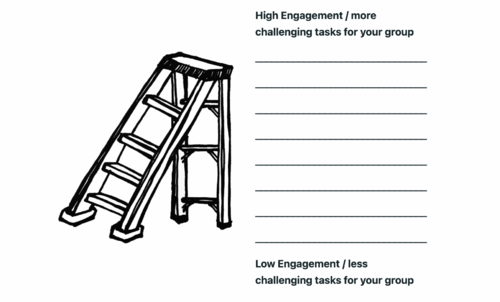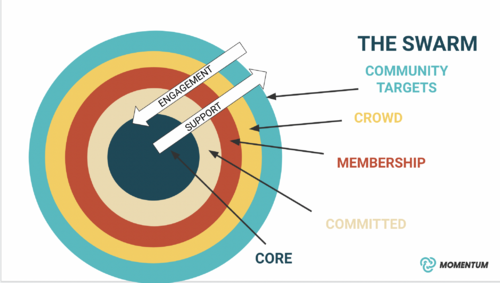Mobilizing and activating members: recruitment and retention 101: Difference between revisions
| Line 74: | Line 74: | ||
*'''Take action! '''Actions are a great opportunity to hand out flyers to people passing by, and giving existing members the feeling of having an impact keeps everyone motivated (rather than sitting through endless meetings). | *'''Take action! '''Actions are a great opportunity to hand out flyers to people passing by, and giving existing members the feeling of having an impact keeps everyone motivated (rather than sitting through endless meetings). | ||
*Don't neglect the value of '''joy and connection''' in mobilizing. These are the elements that both draw people in and help them to stay. Invest intentional time into getting to now one another, and having fun together! Examples might include going out for coffee together, having a potluck, attending a local music event etc. | *Don't neglect the value of '''joy and connection''' in mobilizing. These are the elements that both draw people in and help them to stay. Invest intentional time into getting to now one another, and having fun together! Examples might include going out for coffee together, having a potluck, attending a local music event etc. | ||
*Ask people for their '''accessibility needs'''; what is keeping them from attending meetings or actions? How can you make engagement more accessible to them? See our wiki on [[making your activism | *Ask people for their '''accessibility needs'''; what is keeping them from attending meetings or actions? How can you make engagement more accessible to them? See our wiki on [[making your activism accessible]] for more. | ||
<br> | <br> | ||
Revision as of 22:25, 12 December 2022
The following resource was compiled using existing organizer databases and resources by movement thinkers on mobilizing new members, and using thoughts from grassroots organizers within the hub's community of practice. This guide was developed in response to request from grassroots groups asking for tips on growing their membership, that is, on effective recruitment and retention strategies.
Learning circle participants shared the following ideas related to recruitment and retention:
- Using Divest McGill as an example, take over a space for recruitment! We took over space on campus for 3 days, so lots of community building and recruitment was achieved.
- Divest McGill made a document to inform incoming members of who the board of directors (the targets) for their campaign were, complete with their names, photos and info on each. Helps new members plug in.
- Using divest McGill as an example, take your time. Do not organize a meeting too soon after sending a message (allow people to free up their time). Mention an understanding for the lack of time of those who commit.
- In my group at university, we had the privilege of having a garden on campus. This was a big plus for students who wanted to come out and join us in the garden. An outdoor space helps with recruitment!
- In some schools, a bootcamp (3 day online intensive) to get people up to speed on information, and bring the information to new people, is helpful. The important thing is to keep the relationships!
Modelling strategies using the ladder of engagement [1]
The ladder of engagement can be a helpful tool for describing how folks who are not involved in your group can become engaged, whilst also considering how they can increase their engagement towards becoming more active members. Someone who is a “1,” or at the bottom of the ladder in the model has no connection to your campaign or issue, and a “5” is someone who is ready to show up at an action.
The ladder can be modelled by listing different ways people can take action, in order from lowest engagement required to high engagement. For example, watching a social media video to educate themselves on the issue would be a low engagement action. Moving up the ladder might look like following up with signing a petition. Actions can escalate in intensity and/or demand or requirements of the individual as they move up the ladder and become more active. For example, an action that's higher on your ladder of engagement might be facilitating a team meeting, or organizing a road blockade.
Of course, this is just an outline. Some people might be more willing to participate in an action that make phone calls. The idea, however, is to paint a picture of which actions have the fewest barriers to entry, that can encourage folks to get more involved as active members.

Image by: 350.org
Modelling strategies using the circles of commitment [2]
Similar to the ladder of engagement, the circles of commitment helps to model how involved people are in your group, and can help outline how you plan to move people from the outer circles (low commitment) to the inner circles (high commitment).

Diagram from: Momentum Training Community
Community targets: Audiences you try to reach out to and engage; those not yet involved with your group in any capacity. *Note: see 'community mapping' below for examples of how to define your targets. This is critical to move people into the middle of the circle!
Levels of the circles of commitment
Crowd: Your mailing list and/or social media following.
Membership: those who regularly participates; can include folks who show up at your demos
Committed: High action takers.
Core: Steers a lot of the group's direction; typically those who have been in the group the longest, or who have the most lived and/or organizing experience.
Moving people from the community into the crowd
Examples of strategies might include:
- Social media posts with messaging targeted to the particular audience you want to engage.
- Handing out info sheets at actions.
- Writing opinion pieces or reaching out to the local media to amplify your group's message and/or actions
Moving people from the crowd into the membership or committed circles
Examples of strategies might include:
- Holding regular social/meet up/welcome events for new or interested members to learn more about the group, and more about those involved
- Promoting positions or tasks that need filling on social media
Community Mapping
Other suggestions
- Take action! Actions are a great opportunity to hand out flyers to people passing by, and giving existing members the feeling of having an impact keeps everyone motivated (rather than sitting through endless meetings).
- Don't neglect the value of joy and connection in mobilizing. These are the elements that both draw people in and help them to stay. Invest intentional time into getting to now one another, and having fun together! Examples might include going out for coffee together, having a potluck, attending a local music event etc.
- Ask people for their accessibility needs; what is keeping them from attending meetings or actions? How can you make engagement more accessible to them? See our wiki on making your activism accessible for more.
If you have any suggested revisions or additional resources to share related to the above content, please email them to kenzie@lehub.ca.
